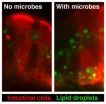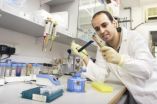(Press-News.org) Using newly available genetic sequencing scientists discovered cells infected with prions (the infectious agent responsible for these diseases) release particles which contain easily recognized 'signature genes'.
Associate Professor Andrew Hill — from the Department of Biochemistry and Molecular Biology at the Bio21 Institute — said these particles travel in the blood stream, making a diagnostic blood test a possibility.
"This might provide a way to screen people who have spent time in the UK, who currently face restrictions on their ability to donate blood," he said.
"With a simple blood test nurses could deem a prospective donor's blood as healthy, with the potential to significantly boost critical blood stocks."
Mad Cow disease was linked to the deaths of nearly 200 people in Great Britain who consumed meat from infected animals in the late 1980s.
Since 2000, the Australia Red Cross Blood Service has not accepted blood from anybody who lived in the UK for more than six months between 1980 and 1996, or who received a blood transfusion in the UK after 1980.
The research is published in this week's Oxford University Press Nucleic Acids Research journal — http://nar.oxfordjournals.org/content/early/2012/09/08/nar.gks832.full.
Lead author Dr Shayne Bellingham said the breakthrough might also help detect other human neurodegenerative diseases, such as Alzheimer's and Parkinson's.
"This is an exciting new field where we can test for conditions in the brain and throughout the body, without being invasive," he said.
The researchers' genetic testing focused on a form of cell discharge called exosomes.
If exosomes were infected with prions (the pathogen that causes Creutzfeldt-Jakob Disease and Bovine Spongiform Encephalopathy, commonly known as Mad Cow Disease) they were found to also carry a specific signature of small genes called microRNA's.
###The research was undertaken at the University of Melbourne, with assistance from the Mental Health Research Institute of Victoria, the National Health and Medical Research Council and the Australian Research Council.
'Mad Cow' blood test now on the horizon
2012-09-12
ELSE PRESS RELEASES FROM THIS DATE:
Gut microbes help the body extract more calories from food
2012-09-12
CHAPEL HILL, N.C. – You may think you have your food all to yourself, but you're actually sharing it with a vast community of microbes waiting within your digestive tract. A new study from the University of North Carolina School of Medicine reveals some gut microbes increase the absorption of dietary fats, allowing the host organism to extract more calories from the same amount of food.
"This study is the first to demonstrate that microbes can promote the absorption of dietary fats in the intestine and their subsequent metabolism in the body," said senior study author ...
Age, not underlying diagnosis, key factor in weight gain in children after tonsillectomy
2012-09-12
Potentially worrisome weight gains following tonsillectomy occur mostly in children under the age of 6, not in older children, a study by Johns Hopkins experts in otolaryngology- head and neck surgery shows.
Sudden increases in body mass index, or BMI, have been routinely observed for months after some of the more than half-million surgeries performed annually in the United States to remove the sore and swollen tissues at the back of the throat.
The Johns Hopkins study, in 115 children in the Baltimore region, is believed to be the first to dispel long-held beliefs ...
A celestial witch's broom?
2012-09-12
The Pencil Nebula is pictured in a new image from ESO's La Silla Observatory in Chile. This peculiar cloud of glowing gas is part of a huge ring of wreckage left over after a supernova explosion that took place about 11 000 years ago. This detailed view was produced by the Wide Field Imager on the MPG/ESO 2.2-metre telescope.
Despite the tranquil and apparently unchanging beauty of a starry night, the Universe is far from being a quiet place. Stars are being born and dying in an endless cycle, and sometimes the death of a star can create a vista of unequalled beauty as ...
Studies shed light on how to reduce the amount of toxins in plant-derived foods
2012-09-12
A number of environmental toxins pose considerable health threats to humans, and the heavy metal cadmium (Cd) ranks high on the list. Most of us are exposed to it through plant-derived foods such as grains and vegetables. Now, new research offers ways in which investigators can reduce the amount of Cd found in the food we eat, according to a review published online September 12th in the Cell Press journal Trends in Plant Science.
"Cadmium is virtually everywhere in the environment, and it is taken up into the human body and bioaccumulates for decades in the kidney," ...
Gut bacteria increase fat absorption
2012-09-12
Baltimore, MD —You may think you have dinner all to yourself, but you're actually sharing it with a vast community of microbes waiting within your digestive tract. A new study from a team including Carnegie's Steve Farber and Juliana Carten reveals that some gut microbes increase the absorption of dietary fats, allowing the host organism to extract more calories from the same amount of food.
Previous studies showed gut microbes aid in the breakdown of complex carbohydrates, but their role in dietary fat metabolism remained a mystery, until now. The research is published ...
Sandia, OurEnergyPolicy.org release 'Goals of Energy Policy' poll results
2012-09-12
LIVERMORE, Calif.— U.S. energy policy should simultaneously pursue security of its energy supply, economic stability and reduced environmental impacts, says a national poll of energy professionals jointly prepared by Sandia National Laboratories and OurEnergyPolicy.org.
The findings of the national poll, "The Goals of Energy Policy," show that the vast majority — more than 85 percent — of the 884 energy professionals surveyed prefer policymaking that pursues all three goals at once.
The poll asked the experts to allocate 100 points, representing a 100 percent policymaking ...
New paper addresses causes of shattering glass cookware; Margin of safety described as 'borderline'
2012-09-12
A new paper appearing in the September 2012 edition of the Bulletin of The American Ceramic Society for the first time provides a scientific explanation of why some glass cookware sold in the United States is more susceptible than others to "explosive" shattering and the possibility of exposing consumers to injury from flying glass shards.
Clear glass baking dishes and pots are a staple in many households around the world and have been since they were first introduced in 1915 to consumers by the Corning Glass Works, which created the Pyrex brand name. The original Pyrex ...
Old deeds, witness trees offer glimpse of pre-settlement forest in West Virginia
2012-09-12
PARSONS, W. Va., September 12, 2012 – Using old deeds and witness trees, a U.S. Forest Service scientist has created a glimpse of the composition of the forests that covered today's Monongahela National Forest before settlement and logging changed the landscape.
"European Settlement-Era Vegetation of the Monongahela National Forest, West Virginia" describes how a Forest Service scientist and her West Virginia University colleague answered questions about the composition of early forests using a unique dataset. The dataset was built with original deeds, metes and bounds ...
Predicting a die throw
2012-09-12
Vegas, Monte Carlo, and Atlantic City draw people from around the world who are willing to throw the dice and take their chances. Researchers from the Technical University of Lodz, Poland, have spotted something predictable in the seemingly random throw of the dice. By applying chaos theory and some high school level mechanics, they determined that by knowing the initial conditions – such as the viscosity of the air, the acceleration of gravity, and the friction of the table – it should be possible to predict the outcome when rolling the dice.
The researchers created ...
A carefully scheduled high-fat diet resets metabolism and prevents obesity
2012-09-12
New research from the Hebrew University of Jerusalem shows that a carefully scheduled high-fat diet can lead to a reduction in body weight and a unique metabolism in which ingested fats are not stored, but rather used for energy at times when no food is available.
The research was conducted by Prof. Oren Froy along with Prof. Zecharia Madar, research student Yoni Genzer and research fellow Dr. Hadas Sherman at the Institute of Biochemistry, Food Science and Nutrition, at the Hebrew University's Robert H. Smith Faculty of Agriculture, Food and Environment. The results ...



